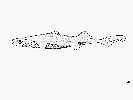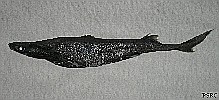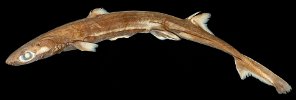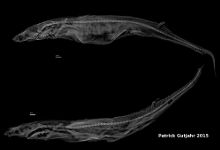Etmopterus lucifer
Jordan & Snyder, 1902
Blackbelly lanternshark
Classification: Elasmobranchii Squaliformes Etmopteridae
Reference of the original description
Descriptions of two new species of squaloid sharks from Japan. Proceedings of the United States National Museum, 25(1279), 79–81
Descriptions of two new species of squaloid sharks from Japan. Proceedings of the United States National Museum, 25(1279), 79–81
Image of the original description

Etmopterus lucifer Jordan & Snyder, 1902

Etmopterus lucifer Jordan & Snyder, 1902
Synonyms / new combinations and misspellings
Etmopterus burgessi, Etmopterus cf. lucifer, Spinax lucifer
Etmopterus burgessi, Etmopterus cf. lucifer, Spinax lucifer
Types
Etmopterus lucifer
Lectotype: SU: 6863; Paralectotype: SU: 7832; USNM: 50728;
Etmopterus burgessi
Holotype: CAS: 223476; Paratype: CAS: 223479; CAS: 223477; CAS: 223478;
Etmopterus lucifer
Lectotype: SU: 6863; Paralectotype: SU: 7832; USNM: 50728;
Etmopterus burgessi
Holotype: CAS: 223476; Paratype: CAS: 223479; CAS: 223477; CAS: 223478;
Description :
Citation: Etmopterus lucifer Jordan & Snyder, 1902: In: Database of modern sharks, rays and chimaeras, www.shark-references.com, World Wide Web electronic publication, Version 01/2026
Please send your images of "Etmopterus lucifer" to info@shark-references.com

Etmopterus lucifer Jordan & Snyder, 1902 (MNHN 2712, BPS-0454) © Samuel P. Iglésias, Muséum national d’Histoire naturelle, Département Milieux et Peuplements Aquatiques Chondrichthyans from the North-eastern Atlantic and the Mediterranean

Etmopterus lucifer Jordan & Snyder, 1902 (MNHN 2712, BPS-0454) © Samuel P. Iglésias, Muséum national d’Histoire naturelle, Département Milieux et Peuplements Aquatiques Chondrichthyans from the North-eastern Atlantic and the Mediterranean
Common names
 Tollo lucero diablo,
Tollo lucero diablo,  Sagre lucifer,
Sagre lucifer,  Blackbelly lantern shark,
Blackbelly lantern shark,  Blackbelly lanternshark,
Blackbelly lanternshark,  Lucifer dogfish,
Lucifer dogfish,  Lucifer shark,
Lucifer shark,  Luminous shark,
Luminous shark,  Lixinha-de-fundura lucifera
Lixinha-de-fundura lucifera
 Tollo lucero diablo,
Tollo lucero diablo,  Sagre lucifer,
Sagre lucifer,  Blackbelly lantern shark,
Blackbelly lantern shark,  Blackbelly lanternshark,
Blackbelly lanternshark,  Lucifer dogfish,
Lucifer dogfish,  Lucifer shark,
Lucifer shark,  Luminous shark,
Luminous shark,  Lixinha-de-fundura lucifera
Lixinha-de-fundura lucifera
Short Description
A moderately small Etmopterus of the E. lucifer group by showing elongated anterior and posterior branches of lateral flank marking, and differing from other members of the E. lucifer group by the following combination of characters: hooklike dermal denticles not overlapping each other, in well-defined rows; origin of second dorsal fin anterior to flank-marking base origin; infracaudal marking not connected with caudal-fin base marking through luminous lines; posterior caudal-fin marking long, its length 23.1–39.8% caudal-fin length; and ventral pectoral marking knife-shaped, straight (after Ng et al. (2025)) [34277]
A moderately small Etmopterus of the E. lucifer group by showing elongated anterior and posterior branches of lateral flank marking, and differing from other members of the E. lucifer group by the following combination of characters: hooklike dermal denticles not overlapping each other, in well-defined rows; origin of second dorsal fin anterior to flank-marking base origin; infracaudal marking not connected with caudal-fin base marking through luminous lines; posterior caudal-fin marking long, its length 23.1–39.8% caudal-fin length; and ventral pectoral marking knife-shaped, straight (after Ng et al. (2025)) [34277]
Distribution
Northwestern Pacific, from sub-boreal northern Japan to the tropical South China Sea, at depths of 300–500 m. Common in Japanese waters and around Taiwan, but seems rare in the northern South China Sea [34277]
Note on the gbif records: The map does not take into account the taxonomic changes from Ng et al. (2025)! [34277] Source: www.gbif.org
Northwestern Pacific, from sub-boreal northern Japan to the tropical South China Sea, at depths of 300–500 m. Common in Japanese waters and around Taiwan, but seems rare in the northern South China Sea [34277]
Note on the gbif records: The map does not take into account the taxonomic changes from Ng et al. (2025)! [34277] Source: www.gbif.org
Human uses
fisheries: of no interest
fisheries: of no interest
Biology
Presumably ovoviviparous [1388]. Size at birth about 15 cm [1388]. Distinct pairing with embrace [17086]. Found on the outer continental and insular shelves and upper slopes [518] (Ref. 75154). Benthopelagic at 183-823 m [17640]. Its luminescent belly may attract prey [578], which consists mainly of squid (reported to bite squid bigger than itself), small bony fishes, and shrimps [518]. Often caught in large schools which may suggest that the luminescence may also be used to keep the group together in the dark deep ocean [578]. Feeds om myctophids and cephalopods (Ref. 58748).
Presumably ovoviviparous [1388]. Size at birth about 15 cm [1388]. Distinct pairing with embrace [17086]. Found on the outer continental and insular shelves and upper slopes [518] (Ref. 75154). Benthopelagic at 183-823 m [17640]. Its luminescent belly may attract prey [578], which consists mainly of squid (reported to bite squid bigger than itself), small bony fishes, and shrimps [518]. Often caught in large schools which may suggest that the luminescence may also be used to keep the group together in the dark deep ocean [578]. Feeds om myctophids and cephalopods (Ref. 58748).
Size / Weight / Age
Largest examined mature male is 371 mm TL. One female reported to attain about 450 mm TL (Dolganov 2006). Schaaf-Da Silva and Ebert (2006) considered the largest female paratype of E. burgessi (CAS 223477, 405 mm TL) to be mature, however, the gonads of this specimen were not available for observation as it was not dissected, thus, the maturity cannot be determined by us. No mature female was examined in the present study. The lectotype (designated herein) represents the smallest mature male examined (264 mm TL). The size at birth is about 131 mm TL. [34277]
Largest examined mature male is 371 mm TL. One female reported to attain about 450 mm TL (Dolganov 2006). Schaaf-Da Silva and Ebert (2006) considered the largest female paratype of E. burgessi (CAS 223477, 405 mm TL) to be mature, however, the gonads of this specimen were not available for observation as it was not dissected, thus, the maturity cannot be determined by us. No mature female was examined in the present study. The lectotype (designated herein) represents the smallest mature male examined (264 mm TL). The size at birth is about 131 mm TL. [34277]
Dentition
Descripion: Teeth dissimilar in upper and lower jaw, exhibiting ontogenetic change and sexual dimorphism; upper teeth multicuspid in three functional series; lower teeth unicuspid, in three series, one functional; lower teeth blade-like, with strongly oblique cusp. No distinctive symphyseal and intermediate teeth. Upper teeth cusp thick; immature males and females with 1–2, rarely 3 cusplets on each side of the upper teeth, while mature males having 3, rarely 2 or 4 cusplets; longest cusplet length about twothird of the cusp in mature individuals; cusp and cusplets of upper teeth narrowly triangular, lower teeth of mature individuals not erected. Tooth count of upper jaw 22–28 (25), lower jaw 25–35, total count 47–62 [34277]
Descripion: Teeth dissimilar in upper and lower jaw, exhibiting ontogenetic change and sexual dimorphism; upper teeth multicuspid in three functional series; lower teeth unicuspid, in three series, one functional; lower teeth blade-like, with strongly oblique cusp. No distinctive symphyseal and intermediate teeth. Upper teeth cusp thick; immature males and females with 1–2, rarely 3 cusplets on each side of the upper teeth, while mature males having 3, rarely 2 or 4 cusplets; longest cusplet length about twothird of the cusp in mature individuals; cusp and cusplets of upper teeth narrowly triangular, lower teeth of mature individuals not erected. Tooth count of upper jaw 22–28 (25), lower jaw 25–35, total count 47–62 [34277]
Remarks
shark-references Species-ID=2177; Links:
digital version of the original description of E. lucifer: JORDAN, D.S. & SNYDER, J.O. 1902: Descriptions of two new species of squaloid sharks from Japan. Proceedings of the United States National Museum, 25 (1279): 79-81"
digital version of the original description of E. abernethyi: GARRICK, J.A.F. 1957: Studies on New Zealand Elasmobranchii. Part VI. Two new species of Etmopterus from New Zealand. Bulletin of the Museum of Comparative Zoology at Harvard College, 116 (3): 169-190"
species description at Digital Fish Library
shark-references Species-ID=2177; Links:
digital version of the original description of E. lucifer: JORDAN, D.S. & SNYDER, J.O. 1902: Descriptions of two new species of squaloid sharks from Japan. Proceedings of the United States National Museum, 25 (1279): 79-81"
digital version of the original description of E. abernethyi: GARRICK, J.A.F. 1957: Studies on New Zealand Elasmobranchii. Part VI. Two new species of Etmopterus from New Zealand. Bulletin of the Museum of Comparative Zoology at Harvard College, 116 (3): 169-190"
species description at Digital Fish Library
Parasites (arranged by Jürgen Pollerspöck)
Cestoda
Copepoda
Cestoda
Copepoda
- Neoalbionella etmopteri (Yamaguti, 1939) [16562]





















